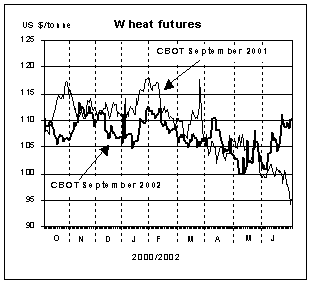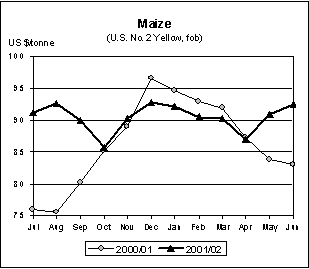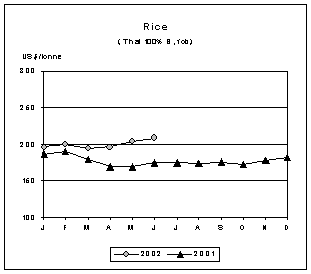| 2002 | 2001 | ||
| June | April | June | |
| (. . . . . . US$/tonne . . . . . .) | |||
| United States | |||
| Wheat | 133 | 125 | 130 |
| Maize | 92 | 87 | 83 |
| Sorghum | 95 | 89 | 93 |
| Argentina | |||
| Wheat | 150 | 121 | 127 |
| Maize | 92 | 86 | 83 |
| Thailand | |||
| Rice white | 210 | 197 | 175 |
| Rice, broken | 152 | 149 | 133 |
International wheat prices rose considerably over the past two months, mostly in response to less favourable crop prospects in a number of major exporting countries. In June, the U.S. wheat No. 2 (HRW, fob) averaged US$133 per tonne, up US$8 per tonne from April and US$3 per tonne more than in the corresponding month last year. However, the increase in US soft wheat prices have been less pronounced mainly because of large supplies of low quality wheat from non-traditional sources, especially from India and Ukraine. Despite the economic problems in Argentina, export commitments are approaching the total availability of around 10 million tonnes and Argentine prices have risen sharply beyond last year’s level. In the EC, large supplies and the strengthening of Euro against the US Dollar have prompted the return of export subsidies (maximum refund of €5).

In the futures market, prices have also been moving up. By late June, the September wheat futures for soft red winter at the Chicago Board of Trade (CBOT) were quoted at US$110 per tonne, up US$16 per tonne from the previous year. With harvests getting underway in most wheat producing countries in the northern hemisphere, seasonal factors could begin putting downward pressure on prices in the coming weeks. However, wheat prices could begin to rise more persistently during the new marketing season just starting in view of generally tighter wheat supplies in major exporting countries.

International maize prices have also strengthened over the past few months with the U.S. No. 2 maize (fob) averaging US$92 per tonne in June, up US$5 per tonne from April and also US$9 per tonne above the corresponding period last year. A faster pace in import purchases in recent weeks has also proven supportive to prices. White maize prices are reported to have made the steepest gains, driven by exceptionally strong demand in southern Africa because of worsening food emergencies. The CBOT maize futures also continued to remain above last year’s values in light of reduced crops in southern hemisphere countries and lower export prospects from Argentina.


The Chicago September maize futures surged to US$90 in late June, up US$14 from the previous year. Unlike the case of wheat, the outlook for maize prices is uncertain. On one hand, the overall world import demand points to a small increase from the previous season but large supplies of feed wheat could undermine demand for maize in some markets while the size of exportable supplies in China and Brazil remains difficult to gauge.
International rice prices have risen slightly since the last report, as reflected in the FAO Export Price Index for Rice (1982-84 =100), which since April has risen by 1 point to 90 points. A tightening of supplies from Pakistan and Viet Nam, has created some buoyancy towards prices, but policy intervention by other major exporting countries, notably India and Thailand, has also been supportive to prices in recent months. In India, prices of FCI stocks for export have been subject to increases, while in Thailand, the continuation of the official procurement programme has contributed to stronger export prices.

In June, the Thai 100% B surpassed the US$200 per tonne benchmark for the first time in two years, being quoted at US$210 per tonne. Although prices for the United States long grain 2/4 percent also recovered in May and June, at US$202 per tonne, they fell for the first time below their Thai counterpart quotations. For comparison, this same rice was quoted US$282 per tonne in June 2001.
Prospects in the next few months remain rather subdued, as the production outlook of countries in the northern hemisphere has somewhat improved and global import prospects have been lowered.